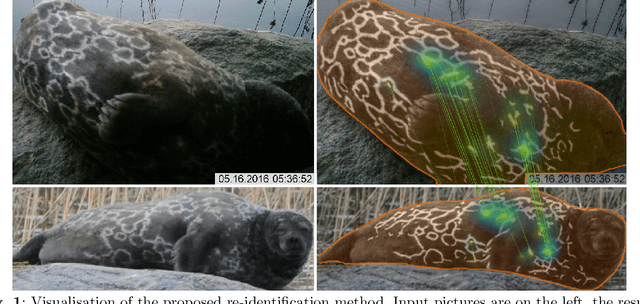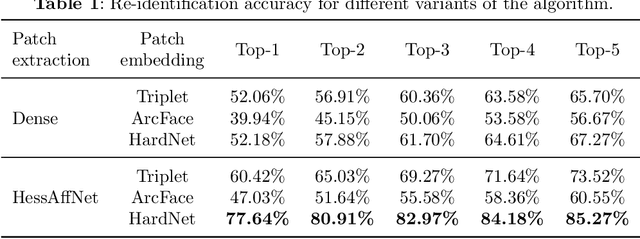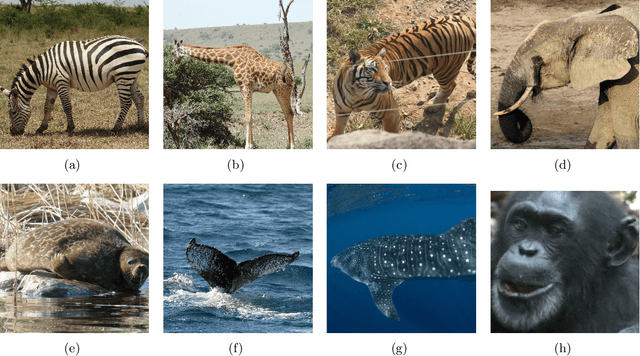Ekaterina Nepovinnykh
Unsupervised Pelage Pattern Unwrapping for Animal Re-identification
Jun 18, 2025Abstract:Existing individual re-identification methods often struggle with the deformable nature of animal fur or skin patterns which undergo geometric distortions due to body movement and posture changes. In this paper, we propose a geometry-aware texture mapping approach that unwarps pelage patterns, the unique markings found on an animal's skin or fur, into a canonical UV space, enabling more robust feature matching. Our method uses surface normal estimation to guide the unwrapping process while preserving the geometric consistency between the 3D surface and the 2D texture space. We focus on two challenging species: Saimaa ringed seals (Pusa hispida saimensis) and leopards (Panthera pardus). Both species have distinctive yet highly deformable fur patterns. By integrating our pattern-preserving UV mapping with existing re-identification techniques, we demonstrate improved accuracy across diverse poses and viewing angles. Our framework does not require ground truth UV annotations and can be trained in a self-supervised manner. Experiments on seal and leopard datasets show up to a 5.4% improvement in re-identification accuracy.
Optimizing Image Capture for Computer Vision-Powered Taxonomic Identification and Trait Recognition of Biodiversity Specimens
May 22, 2025Abstract:Biological collections house millions of specimens documenting Earth's biodiversity, with digital images increasingly available through open-access platforms. Most imaging protocols were developed for human visual interpretation without considering computational analysis requirements. This paper aims to bridge the gap between current imaging practices and the potential for automated analysis by presenting key considerations for creating biological specimen images optimized for computer vision applications. We provide conceptual computer vision topics for context, addressing fundamental concerns including model generalization, data leakage, and comprehensive metadata documentation, and outline practical guidance on specimen imagine, and data storage. These recommendations were synthesized through interdisciplinary collaboration between taxonomists, collection managers, ecologists, and computer scientists. Through this synthesis, we have identified ten interconnected considerations that form a framework for successfully integrating biological specimen images into computer vision pipelines. The key elements include: (1) comprehensive metadata documentation, (2) standardized specimen positioning, (3) consistent size and color calibration, (4) protocols for handling multiple specimens in one image, (5) uniform background selection, (6) controlled lighting, (7) appropriate resolution and magnification, (8) optimal file formats, (9) robust data archiving strategies, and (10) accessible data sharing practices. By implementing these recommendations, collection managers, taxonomists, and biodiversity informaticians can generate images that support automated trait extraction, species identification, and novel ecological and evolutionary analyses at unprecedented scales. Successful implementation lies in thorough documentation of methodological choices.
Understanding the Impact of Training Set Size on Animal Re-identification
May 24, 2024Abstract:Recent advancements in the automatic re-identification of animal individuals from images have opened up new possibilities for studying wildlife through camera traps and citizen science projects. Existing methods leverage distinct and permanent visual body markings, such as fur patterns or scars, and typically employ one of two strategies: local features or end-to-end learning. In this study, we delve into the impact of training set size by conducting comprehensive experiments across six different methods and five animal species. While it is well known that end-to-end learning-based methods surpass local feature-based methods given a sufficient amount of good-quality training data, the challenge of gathering such datasets for wildlife animals means that local feature-based methods remain a more practical approach for many species. We demonstrate the benefits of both local feature and end-to-end learning-based approaches and show that species-specific characteristics, particularly intra-individual variance, have a notable effect on training data requirements.
Combining feature aggregation and geometric similarity for re-identification of patterned animals
Aug 11, 2023



Abstract:Image-based re-identification of animal individuals allows gathering of information such as migration patterns of the animals over time. This, together with large image volumes collected using camera traps and crowdsourcing, opens novel possibilities to study animal populations. For many species, the re-identification can be done by analyzing the permanent fur, feather, or skin patterns that are unique to each individual. In this paper, we address the re-identification by combining two types of pattern similarity metrics: 1) pattern appearance similarity obtained by pattern feature aggregation and 2) geometric pattern similarity obtained by analyzing the geometric consistency of pattern similarities. The proposed combination allows to efficiently utilize both the local and global pattern features, providing a general re-identification approach that can be applied to a wide variety of different pattern types. In the experimental part of the work, we demonstrate that the method achieves promising re-identification accuracies for Saimaa ringed seals and whale sharks.
NORPPA: NOvel Ringed seal re-identification by Pelage Pattern Aggregation
Jun 07, 2022



Abstract:We propose a method for Saimaa ringed seal (Pusa hispida saimensis) re-identification. Access to large image volumes through camera trapping and crowdsourcing provides novel possibilities for animal monitoring and conservation and calls for automatic methods for analysis, in particular, when re-identifying individual animals from the images. The proposed method NOvel Ringed seal re-identification by Pelage Pattern Aggregation (NORPPA) utilizes the permanent and unique pelage pattern of Saimaa ringed seals and content-based image retrieval techniques. First, the query image is preprocessed, and each seal instance is segmented. Next, the seal's pelage pattern is extracted using a U-net encoder-decoder based method. Then, CNN-based affine invariant features are embedded and aggregated into Fisher Vectors. Finally, the cosine distance between the Fisher Vectors is used to find the best match from a database of known individuals. We perform extensive experiments of various modifications of the method on a new challenging Saimaa ringed seals re-identification dataset. The proposed method is shown to produce the best re-identification accuracy on our dataset in comparisons with alternative approaches.
SealID: Saimaa ringed seal re-identification dataset
Jun 07, 2022



Abstract:Wildlife camera traps and crowd-sourced image material provide novel possibilities to monitor endangered animal species. However, massive image volumes that these methods produce are overwhelming for researchers to go through manually which calls for automatic systems to perform the analysis. The analysis task that has gained the most attention is the re-identification of individuals, as it allows, for example, to study animal migration or to estimate the population size. The Saimaa ringed seal (Pusa hispida saimensis) is an endangered subspecies only found in the Lake Saimaa, Finland, and is one of the few existing freshwater seal species. Ringed seals have permanent pelage patterns that are unique to each individual which can be used for the identification of individuals. Large variation in poses further exacerbated by the deformable nature of seals together with varying appearance and low contrast between the ring pattern and the rest of the pelage makes the Saimaa ringed seal re-identification task very challenging, providing a good benchmark to evaluate state-of-the-art re-identification methods. Therefore, we make our Saimaa ringed seal image (SealID) dataset (N=57) publicly available for research purposes. In this paper, the dataset is described, the evaluation protocol for re-identification methods is proposed, and the results for two baseline methods HotSpotter and NORPPA are provided. The SealID dataset has been made publicly available.
EDEN: Deep Feature Distribution Pooling for Saimaa Ringed Seals Pattern Matching
May 28, 2021



Abstract:In this paper, pelage pattern matching is considered to solve the individual re-identification of the Saimaa ringed seals. Animal re-identification together with the access to large amount of image material through camera traps and crowd-sourcing provide novel possibilities for animal monitoring and conservation. We propose a novel feature pooling approach that allow aggregating the local pattern features to get a fixed size embedding vector that incorporate global features by taking into account the spatial distribution of features. This is obtained by eigen decomposition of covariances computed for probability mass functions representing feature maps. Embedding vectors can then be used to find the best match in the database of known individuals allowing animal re-identification. The results show that the proposed pooling method outperforms the existing methods on the challenging Saimaa ringed seal image data.
 Add to Chrome
Add to Chrome Add to Firefox
Add to Firefox Add to Edge
Add to Edge